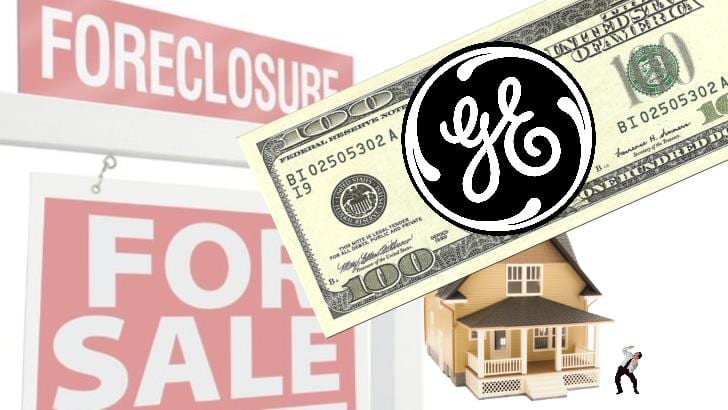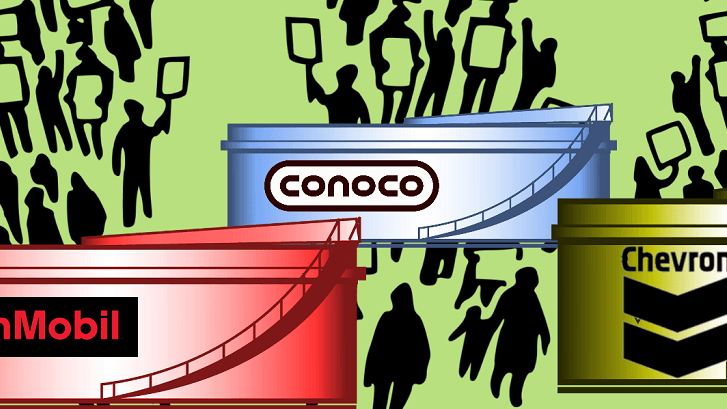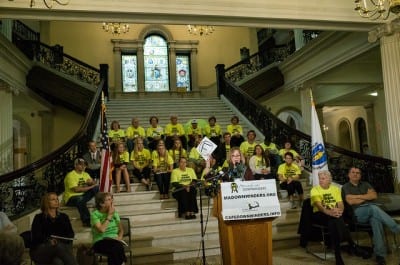
Image by Kent Buckley
February 1, 2016
BY JASON PRAMAS @JASONPRAMAS
Two weeks after the first installment of this Missing Manual, we now know that GE will receive up to another $100 million of Boston’s largesse in the form of reopening the Old Northern Avenue Bridge and $25 million in state money for work on roads, pedestrian walkways, and bike lanes near the corporation’s new Seaport District HQ. Pushing the total giveaway to over $270 million in public funds.
Gov. Charlie Baker, Mayor Marty Walsh, and boosters like the Boston Globe claim that the investment will be worth it. Yet GE’s record of slashing jobs, despoiling the environment, and evading taxes says otherwise. And their role in the subprime mortgage crisis further repudiates such official optimism.
Back in 1999, the Glass-Steagall Act—a critical piece of Depression-era social legislation that put up a firewall between commercial banks and investment houses—was torpedoed by Congress. One of the excuses for the deregulatory push was the claim that so-called “shadow banks”—institutions that perform banking functions outside of the traditional system of federally-regulated banks—were doing great business with less regulation. The now-diminished GE Capital was then one of the largest shadow banks, since as the finance arm of an industrial concern it was not classified as a bank. Thanks to that fact and the happy coincidence that GE Capital owned a small Utah savings and loan operation, it was allowed to “engage in banking under the lighter hand of the Office of Thrift Supervision.” Rather than the more strict banking regulations overseen by the Federal Reserve—which do not allow banks to engage in commerce—according to a 2009 report by ProPublica and the Washington Post.
Ironically, the deregulation of the banking system proved to be a key factor in the 2007 subprime mortgage crisis and the resulting 2008 financial crisis. And the much-praised practices of shadow banks like GE Capital were precisely the ones that nearly wiped out the US economy. GE had long used GE Capital, equivalent to the seventh largest banking company in the US until 2008, to fatten its bottom line. According to Maureen Farrell of the Wall Street Journal, “GE got into lending decades ago and grew that arm of its business steadily in the years before the crisis, as it was able to leverage its triple-A credit rating for access to cheap capital. Before the credit crisis, GE relied upon lending for around 50 percent of its earnings.”
So in 2004 GE Capital had plenty of ready cash to buy California-based WMC Mortgage Corp.—a company that specialized in foisting subprime housing loans on poor families that couldn’t really afford them, using highly unethical sales tactics—for about half a billion dollars. According to a 2012 report by Michael Hudson of The Center for Public Integrity, even before the purchase, WMC “… was producing $8 billion a year in subprime home loans and boasting profits of $140 million a year.”
Then in 2006, US housing prices declined sharply. Subprime borrowers with no reserve cash were unable to refinance their home loans as their adjustable-rate mortgage payments increased mercilessly. Subprime lenders then began to automatically slap late-paying borrowers with even higher penalty rates. More and more people defaulted on their loans. Lenders like WMC suddenly went from being cash-rich to being cash-poor.
GE Capital was hemorrhaging money by 2007. During the first half of that year WMC lost over $500 million as the mortgage industry “spun into chaos.” By October 2007, the Center for Public Integrity report concludes, “WMC Mortgage was effectively out of business, dead after having pumped out roughly $110 billion in subprime and ‘Alt-A’ loans under GE’s watch.”
Meanwhile, GE Capital, like many other financial institutions of the period, had rolled packages of subprime mortgage debt into Residential Mortgage-Backed Securities (RMBSs)—which it then sold to investors. Including institutional investors like government-sponsored housing lender Freddie Mac. When the WMC subprime mortgages collapsed in 2007, the GE Capital RMBSs based on them followed suit. And the whole house of cards built on bad mortgages to poor people fell down. GE Capital immediately put hundreds of millions of dollars aside to pay off its investors. But not its mortgage holders. WMC-issued mortgages failed at rates of up to 75 percent in some areas. Ruining the lives of tens of thousands of working families in the process.
GE had gotten out of the subprime racket just in time to stay solvent into 2008. The most significant federal blowback from the episode came in 2011 when the Federal Housing Finance Agency that regulates Freddie Mac sued General Electric for selling them $549 million in subprime-based RMBSs. According to American Banker, they “charged GE’s former mortgage lending unit with presenting a false picture of the riskiness of residential mortgages behind securities that were sold to Freddie Mac.”
GE settled the suit in 2013 for just $6.25 million.
Coming soon in part 3: the 2008 financial crisis and federal bailout of General Electric.
Apparent Horizon is syndicated by the Boston Institute for Nonprofit Journalism. Jason Pramas is BINJ’s network director.
Copyright 2016 Jason Pramas. Licensed for use by the Boston Institute for Nonprofit Journalism and media outlets in its network.









